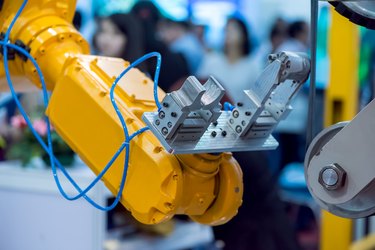
Robots in antiquity and through the Middle Ages were used primarily for entertainment. However, the 20th century featured a boom in the development of industrial robots. Through the rest of the century, robots changed the structure of society and allowed for safer conditions for labor. In addition, the implementation of advanced robotics in the military and NASA has changed the landscape of national defense and space exploration. Robots have also been influential in the media and profitable for toy manufacturers.
History
Video of the Day
Robots began as entertainment for royalty. Inventors such as Al-Jazari and Leonardo Da Vinci worked to build automatons for their benefactors. Al-Jazari built a floating band that resembled humans and performed various songs and drum beats depending on the programming of a series of pegs. Da Vinci created a automaton based on the knight's armor. It could stand and move its arms and neck, as well as open its mouth. It wasn't until 1961--when an inventor named George Devol installed his robot, Unimate, into a General Motors factory in Trenton, New Jersey--that the first modern industrial use of the robot was attempted. Unimate would lift die-cut metal pieces and stack them for the human workers. This development changed the dynamics of robotics and brought them into the workplace, making them pivotal to a business.
Video of the Day
Significance
Industry has benefited drastically from the expanse of a robotic work force. Automated machines have taken over the duties of dangerous and mundane jobs from humans, allowing greater productivity. Because robots never tire, extra shifts have been added to factories. Farmers have taken advantage of new technology with automated harvesters, the waste disposal industry has implemented robots in some of its dirtier jobs, and the medical industry benefits from advancements in assisted surgical robotics. The idea of a factory with no human workers has come to fruition. IBM runs a "lights off" factory in Texas completely staffed by fully autonomous robots making keyboards. The military has launched various programs in robotic technology, most successfully the Predator and Reaper unmanned aerial reconnaissance vehicles that allow a pilot to control the robot from vast distances. The vehicles can do high-altitude surveillance for long periods without having to support a live pilot, and when needed the planes can launch small strikes on targets in zones that normal aircraft cannot operate.
Features
Robots' main position in society are in a capacity to assist humans by taking on the jobs that are dirty, dull or dangerous. Beyond the factory floor, robots have been instrumental in space exploration and performing other tasks that would be impossible for humans to accomplish. The Mars rovers Spirit and Opportunity lasted years longer than NASA predicted and stayed on the mission far past the time any manned mission could have functioned. The Deep Impact probe that crashed into a comet literally functioned at a capacity impossible for humans. The Chernobyl meltdown site contains radiation levels that would kill any human. As such, the Pioneer robot was developed to enter the remains of the facility to address structural stability. Also, the Dante II was utilized to enter volcanic eruptions, which are impossible for humans to investigate.
Considerations
Robots have had a long importance in the media, between our fascination with real-life robotics and their fictional counterparts. The first instance of a robot in a film was in Fritz Lang's "Metropolis." It introduced the concept of a functioning automaton programmed to act as a human. Robots appeared frequently over the course of the next century in films such as "Forbidden Planet" and television programs like "Star Trek." Probably the most famous duo of robots ever are C-3PO and R2-D2 from the "Star Wars" films. The characters brought a humanistic attitude to the previously dry image of robots. In modern cinema, robots have portrayed heroes and villains, both elaborately sophisticated and starkly simplistic. The machines featured in "The Terminator" have long held a scary yet fascinating influence over the culture of robotics.
Misconceptions
Modern robotics are present everywhere in society, from a DVD burner in a computer to the microwave in most American kitchens. The invention of the microprocessor in 1971 caused the computerization of virtually every appliance and tool the modern home uses. Toasters and stoves utilize microprocessors that control sensors to reduce the likelihood of fires, while cellular phones implement virtual memory to enhance interaction. Most toy stores now feature hundreds of robots for educational and entertainment use. With the introduction of the "Furby" in the late 1990s, robots with limited artificial intelligence become a boon for the marketplace, generating vast amounts of revenue in simple consumer-ready robotics.